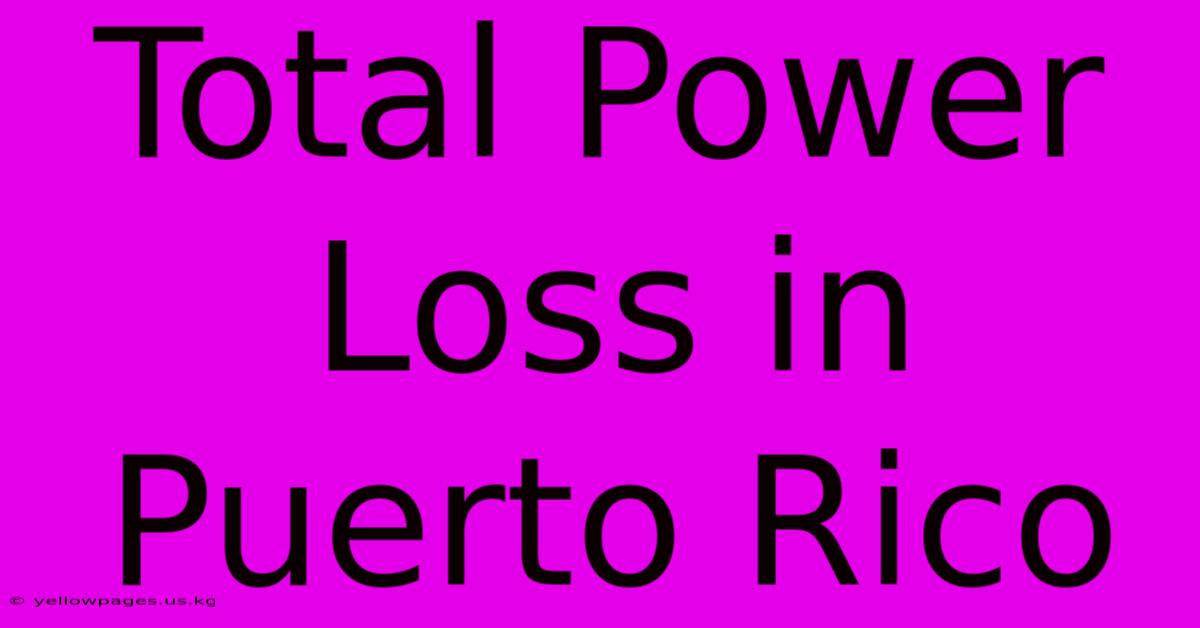Total Power Loss In Puerto Rico

Discover more detailed and exciting information on our website. Click the link below to start your adventure: Visit Best Website trendingnews.us.kg. Don't miss out!
Table of Contents
Total Power Loss in Puerto Rico: A Devastating Reality and the Path to Resilience
Puerto Rico's history is tragically intertwined with devastating power outages. From hurricanes to aging infrastructure, the island has repeatedly faced widespread and prolonged total power loss, leaving its citizens vulnerable and highlighting critical systemic issues. This article delves into the causes, consequences, and ongoing efforts to build a more resilient energy grid for the future.
The Devastating Impacts of Total Power Loss
Total power loss in Puerto Rico isn't just an inconvenience; it's a crisis with far-reaching consequences:
-
Humanitarian Crisis: Without power, access to essential services like healthcare, communication, and clean water is severely compromised. Hospitals struggle to operate, leading to potential medical emergencies. Communication breakdowns hinder rescue and relief efforts. The lack of refrigeration leads to food spoilage, exacerbating food insecurity issues already prevalent on the island.
-
Economic Devastation: Businesses are forced to close, leading to job losses and economic stagnation. Tourism, a vital sector of the Puerto Rican economy, suffers immensely as potential visitors are deterred by the uncertainty and inconvenience. The cost of repairing the power grid and compensating for losses places a significant strain on the already burdened public finances.
-
Social Disruption: Extended power outages disrupt daily life, leading to stress, anxiety, and social unrest. The inability to connect with loved ones, maintain essential services, and access information creates a sense of isolation and vulnerability. The loss of power can exacerbate existing social inequalities, disproportionately affecting vulnerable populations.
Causes of Frequent Power Outages
The frequent occurrence of total power loss in Puerto Rico stems from a complex interplay of factors:
-
Hurricane Vulnerability: The island's location in the hurricane belt makes it highly susceptible to extreme weather events. Hurricanes can cause catastrophic damage to power infrastructure, including downed power lines, damaged substations, and flooded generating facilities.
-
Aging Infrastructure: Puerto Rico's power grid is notoriously outdated and in dire need of modernization. Years of underinvestment and deferred maintenance have resulted in a fragile system vulnerable to failure. The infrastructure is unable to withstand the stress of extreme weather or even normal fluctuations in demand.
-
Lack of Diversification: The island's reliance on a centralized power grid makes it highly vulnerable to widespread outages. A lack of diversification in energy sources and a failure to invest in resilient microgrids leaves the entire system exposed to a single point of failure.
-
Political and Economic Factors: Bureaucracy, corruption, and a lack of adequate funding have hampered efforts to modernize and strengthen the power grid. Complex regulatory processes and competing interests have slowed down progress and contributed to the ongoing crisis.
The Path to Resilience: Modernizing the Power Grid
Addressing the issue of total power loss in Puerto Rico requires a multi-pronged approach focusing on:
-
Grid Modernization: Investing in modernizing the aging infrastructure is crucial. This includes upgrading transmission and distribution lines, replacing outdated equipment, and implementing smart grid technologies to improve efficiency and resilience.
-
Energy Diversification: Moving away from a reliance on a centralized grid and incorporating renewable energy sources such as solar and wind power is essential. Developing microgrids and distributed generation can enhance resilience and reduce vulnerability to large-scale outages.
-
Strengthening Emergency Response: Improving emergency preparedness and response capabilities is critical. This includes developing robust communication systems, pre-positioning emergency supplies, and training personnel to respond effectively to power outages.
-
Community Engagement: Engaging local communities in the planning and implementation of grid modernization initiatives is essential. Community participation ensures that solutions are tailored to local needs and priorities.
Conclusion:
Total power loss in Puerto Rico is a complex problem with far-reaching consequences. Addressing this challenge requires a sustained commitment to modernizing the power grid, diversifying energy sources, and strengthening emergency response capabilities. Building a resilient energy future for Puerto Rico demands a collaborative effort involving government agencies, private sector companies, and the community itself. Only through a concerted and comprehensive approach can the island hope to overcome the devastating impact of total power loss and secure a brighter, more reliable future.

Thank you for visiting our website wich cover about Total Power Loss In Puerto Rico. We hope the information provided has been useful to you. Feel free to contact us if you have any questions or need further assistance. See you next time and dont miss to bookmark.
Featured Posts
-
Washington Louisvilles 2024 Qbs
Jan 01, 2025
-
Nhl Winter Classic 2025 New Years Eve Shift
Jan 01, 2025
-
Puerto Rico Suffers Major Power Failure
Jan 01, 2025
-
New Years Eve Power Failure In Puerto Rico
Jan 01, 2025
-
Nye College Football Bowl Schedule
Jan 01, 2025
